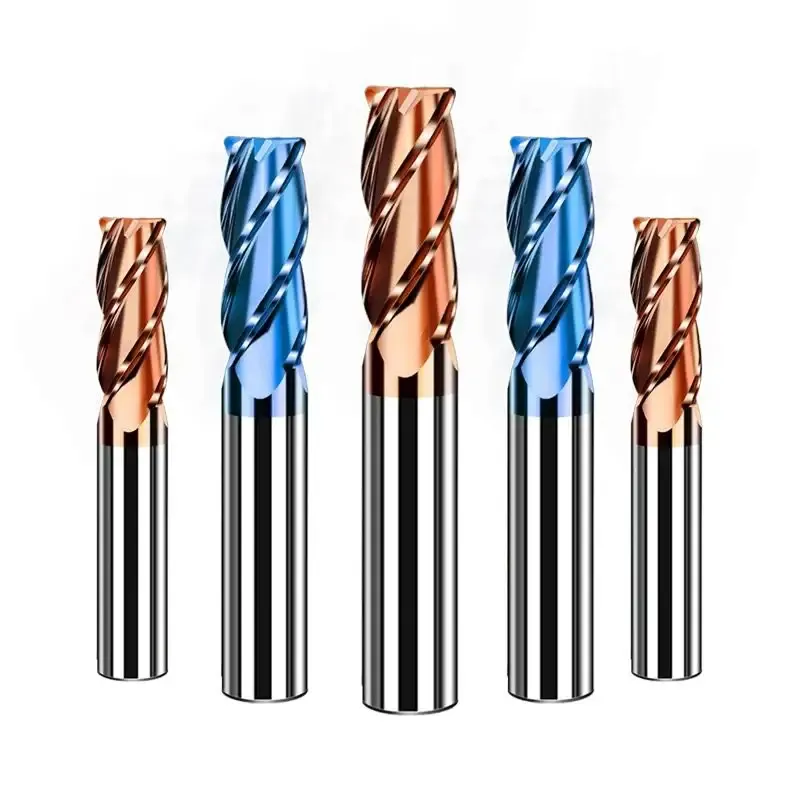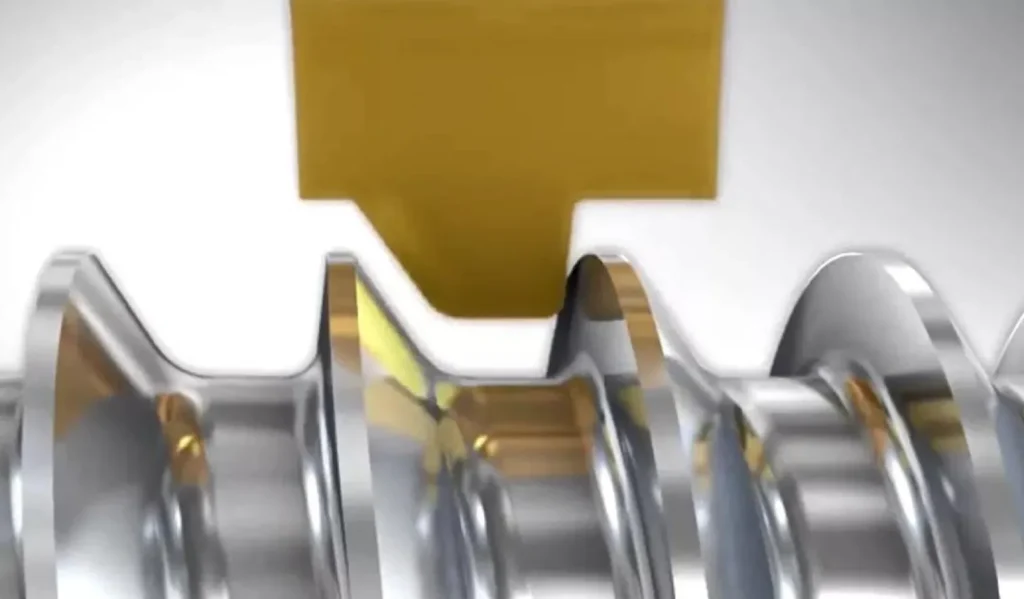카바이드 엔드밀 절삭 파라미터 최적화: 종합 가이드
카바이드 엔드밀 는 정밀 가공에 필수적인 회전 절삭 공구로, 슬롯 가공, 프로파일링, 평면 가공 및 윤곽 가공과 같은 밀링 작업에서 내구성과 효율성이 뛰어나다는 평가를 받고 있습니다. 텅스텐과 탄소와 코발트 바인더의 합성물인 텅스텐 카바이드로 제작되어 고속강(HSS) 공구에 비해 뛰어난 경도(최대 90+ HRA), 내마모성, 내열성을 제공합니다. 따라서 더 빠른 속도와 이송이 가능하여 사이클 시간을 단축하는 동시에 날카로운 모서리를 더 오래 유지할 수 있습니다. 생산성, 표면 정삭, 공구 수명 및 기계 안전의 균형을 맞추려면 스핀들 속도, 이송 속도 및 절삭 깊이와 같은 파라미터를 최적화하는 것이 중요합니다. 잘못된 설정은 과도한 마모, 파손 또는 최적의 결과가 아닌 결과를 초래할 수 있으며, 이상적인 설정은 재료 제거율(MRR)을 극대화하고 비용을 최소화합니다. 이 가이드는 업계 모범 사례를 바탕으로 다양한 재료와 시나리오에 맞는 공식, 표, 팁을 제공합니다.
카바이드 엔드밀의 종류
올바른 유형을 선택하면 매개변수 선택에 영향을 미칩니다:
- 플랫 엔드 밀: 일반적인 평평한 바닥 절단용; 황삭 및 정삭에 다용도로 사용할 수 있습니다.
- 볼 노즈 엔드 밀: 3D 컨투어링 및 금형용; 곡선 형상으로 인해 조정된 피드가 필요합니다.
- 코너 반경 엔드밀: 무거운 황삭을 위해 가장자리를 강화하고 더 높은 이송을 허용합니다.
- 황삭 엔드 밀: 거친 톱니는 대량의 이물질을 제거하며, 낮은 속도는 칩 부하를 관리합니다.
- 테이퍼 엔드 밀: 각진 피처의 경우, 매개변수는 유효 직경에 따라 스케일링됩니다.
TiAlN 또는 AlTiN과 같은 코팅은 열과 마모에 더욱 최적화되어 철 소재에서 20~50% 더 빠른 속도를 구현하는 경우가 많습니다.
키 커팅 매개변수
이를 숙지하여 최적의 성능을 달성하세요:
| 매개변수 | 설명 | 단위(영국식/미터법) | 카바이드 엔드밀의 일반적인 범위 |
|---|---|---|---|
| 스핀들 속도(RPM) | 공구의 분당 회전 수, 절삭 속도 및 열 발생을 제어합니다. | RPM / RPM | 5,000-10,000(직경 및 재질에 따라 다름) |
| 피드 속도 | 공작물로의 이송 속도; 칩 두께와 MRR에 영향을 줍니다. | IPM(인치/분) / mm/분 | 10-100 IPM(치아당 조정) |
| 칩 로드(IPT) | 회전당 플루트당 제거되는 재료, 공구 수명의 핵심입니다. | IPT(인치/치) / mm/치 | 0.001-0.010 IPT |
| 축 방향 컷 심도(ADOC) | 공구 축을 따라 관통하는 힘과 처짐에 영향을 줍니다. | 인치 / mm | 0.5-2.5 × 공구 직경 |
| 방사형 컷 깊이(RDOC) | 축에 수직으로 맞물림(스텝오버 %), 마무리 작업 시 더 낮게 맞물림. | %의 직경 / mm | 황삭용 10-50%, 정삭용 5-10% |
| 냉각수 | 열/칩 제어용 유체, 재료에 따라 플러드, 미스트 또는 건식. | N/A | 스틸/티타늄의 경우 필수, 알루미늄의 경우 선택 사항 |
계산 방법
제조업체 데이터로 시작한 다음 공식을 통해 구체화합니다. 이는 코팅되지 않은 공구를 가정한 것으로, 코팅을 하면 SFM이 10-30% 증가할 수 있습니다. 정밀도를 높이려면 G-Wizard와 같은 소프트웨어를 사용하되, 기본적으로는 수동 계산도 가능합니다.
스핀들 속도(RPM)

- Imperial: RPM = (SFM × 3.82) / 공구 직경(인치)
- Metric: RPM = (Vc × 1,000) / (π × 공구 직경(mm)) SFM(분당 표면 피트) 또는 Vc(m/min)는 재료에 따라 다릅니다(아래 표 참조). 예시: 알루미늄 1/2인치 공구(SFM=800)의 경우 RPM = (800 × 3.82) / 0.5 = 6,112입니다.
2. 피드 속도(IPM)
- Imperial: IPM = RPM × IPT × 플루트 수(T)
- Metricmm/min = RPM × mm/치수 × T IPT(칩 부하)는 MRR과 마모의 균형을 맞추는데, 너무 낮으면 마찰/열이 발생하고 너무 높으면 파손의 위험이 있습니다. 예시: 6,112 RPM, 0.004 IPT, 플루트 4개: IPM = 6,112 × 0.004 × 4 = 98 IPM.
3. 재료 제거율(MRR)
- MRR = ADOC × RDOC × IPM(입방인치/min) 기계 출력을 초과하지 않고 깊이/이송을 늘려 최대화합니다(80% 스핀들 부하를 목표로 함).

최적화에 영향을 미치는 요인
- 공작물 재질: 더 단단하고 마모성이 강한 소재(예: 티타늄)는 낮은 SFM/높은 냉각수가 필요하고, 부드러운 소재(예: 알루미늄)는 공격적인 이송을 허용합니다.
- 도구 지오메트리: 정삭/고RPM용 플루트 수(3-6개)가 많고, 황삭/칩 배출용 플루트 수(2-3개)가 적습니다. 직경이 작을수록 더 빨리 회전하지만 더 많이 휘어집니다.
- 기계 강성: 뻣뻣한 설정은 더 깊은 절단을 허용하고 진동은 감소를 요구합니다.
- 작업 유형: 황삭은 MRR(높은 피드)을 우선시하고, 정삭은 마무리(낮은 RDOC)를 강조합니다.
- 냉각수/환경: 마찰을 30-50%까지 줄임; 고압은 티타늄 칩 파손을 돕습니다.
자료별 권장 사항
집계된 가이드라인에서 이러한 시작점을 사용하고 설정에 따라 10-20%를 테스트하고 조정합니다. 1/4인치 4-플루트 엔드밀의 경우.
비철 소재(예: 알루미늄, 구리)
빠른 속도, 적당한 칩; 냉각수 없이 가장자리가 쌓이기 쉽습니다.
| 재료 | SFM 범위 | IPT(1/4″ 도구) | RPM 예시 | 피드(IPM) 예시 | 팁 |
|---|---|---|---|---|---|
| 알루미늄(6061) | 800-1,500 | 0.002-0.004 | 9,664-18,120 | 77-145 | 거밍을 방지하기 위해 높은 피드, MQL 선호. |
| 황동/구리 | 600-1,000 | 0.001-0.002 | 7,248-12,080 | 29-49 | 밀링을 올리고 가능하면 말립니다. |
| 플라스틱 | 200-600 | 0.003-0.005 | 3,048-9,144 | 37-61 | 날카로운 도구, 녹지 않도록 낮은 열. |
철 소재(예: 강철, 스테인리스)
적당한 속도, 작업 경화를 방지하기 위해 칩 제어에 집중합니다.
| 재료 | SFM 범위 | IPT(1/4″ 도구) | RPM 예시 | 피드(IPM) 예시 | 팁 |
|---|---|---|---|---|---|
| 연강(1018) | 100-300 | 0.001-0.002 | 1,216-3,648 | 5-15 | 홍수 냉각수; 40-60% 스텝오버. |
| 스테인리스(304) | 100-250 | 0.0005-0.001 | 1,216-3,024 | 2-5 | 하부 RDOC(20%), 고압 냉각수. |
| 공구강(A2) | 100-250 | 0.001-0.0015 | 1,216-3,024 | 5-7 | 코팅된 도구; 가장자리가 쌓이는지 모니터링합니다. |
고온 합금 및 티타늄
저속, 조명 차단, 열 관리가 핵심입니다.
| 재료 | SFM 범위 | IPT(1/4″ 도구) | RPM 예시 | 피드(IPM) 예시 | 팁 |
|---|---|---|---|---|---|
| 티타늄(6Al-4V) | 50-250 | 0.0005-0.001 | 608-3,024 | 1-5 | 풍부한 냉각수; 트로코이드 경로로 낮은 교착 상태를 유지합니다. |
| 인코넬 718 | 40-60 | 0.001-0.0015 | 486-728 | 2-4 | 엄격한 설정, 가변 헬릭스 도구로 잡담을 줄입니다. |
RPM 예시: (SFM × 3.82) / 0.25. Feed: RPM × IPT × 4 플루트. 더 큰 직경의 경우 IPT를 20-50%까지 확장합니다.
최적화 전략
- 보수적으로 시작: 최대 권장 SFM/IPT 70-80% 사용, 모니터링하면서 증량합니다.
- 피드백 모니터링: 잡음 듣기(RPM 10% 감소), 칩 확인(짧고 곱슬 = 양호, 끈적임 = 피드 증가).
- 고급 기술:
- 고속 가공(HSM): 가벼운 RDOC(5-10%)로 1,500+ SFM, MRR 2~3배 향상.
- 트로코이드 밀링: 5-15%가 결합된 원형 경로, 슬롯에 이상적이며 수명이 2배 연장됩니다.
- 클라이밍 대 기존: 더 나은 마무리를 위한 상승(동일 방향 이송/공구 회전), 엔트리 컷을 위한 기존 방식.
- 반복: 10% 단위로 조정하고 반복성을 위해 결과를 기록합니다.
일반적인 문제 해결
| 이슈 | 원인 | 솔루션 |
|---|---|---|
| 도구 파손 | 과도한 ADOC/RDOC, 높은 IPT | 수심 20%를 줄이고 강성을 확인합니다. |
| 잡담/진동 | 공명, 편향 | RPM을 변경하고, 더 짧은 도구를 사용하고, 댐퍼를 추가합니다. |
| 불완전한 마감 | 낮은 RPM, 높은 피드 | 속도를 높이고, IPT를 낮추고, 냉각수를 확보하세요. |
| 칩 빌드업 | 부적절한 대피 | 부스트 피드; 냉각수 압력을 최적화합니다. |
| 빠른 마모 | 드라이 런으로 인한 열, 잘못된 SFM | 유체를 적용하고 머티리얼 레코드를 일치시킵니다. |
도구 수명을 위한 모범 사례
- 적합한 코팅을 선택하세요: 공작물 소재에 특별히 최적화된 코팅(예: TiAlN, AlCrN, TiCN)을 선택합니다. 코팅은 경도, 내열성 및 윤활성을 향상시켜 특히 고속 또는 건식 가공에서 공구 수명을 크게 연장합니다.
- 플루트 개수를 머티리얼에 일치시킵니다:
- 낮은 플루트 수(2-3): 비철, 젤리 또는 알루미늄과 같은 부드러운 소재에 이상적입니다. 더 큰 칩 밸리 를 사용하여 칩을 효율적으로 배출하여 칩 재절단 및 포장을 방지합니다.
- 더 많은 플루트 수(5개 이상): 강철, 스테인리스 스틸과 같은 단단한 철 소재에 더 적합합니다. 더 두껍고 단단한 코어 강도와 안정성을 위해.
- 컷 길이(LOC) 최소화: 작업에 필요한 가능한 가장 짧은 LOC/플루트 길이를 사용하세요. 공구가 짧을수록 더 단단하고 휨에 덜 민감하여 진동과 공구 파손이 줄어듭니다.
- 가변 나선/피치 지오메트리를 활용합니다: 가변 나선 각도가 있는 도구 도움말 고조파 진동(채터) 끊기, 를 사용하여 더 매끄러운 절단, 더 나은 마감, 더 긴 공구 수명으로 이어집니다.
- 모서리 반경(불노즈) 도구를 사용합니다: 불노즈 엔드밀(모서리의 반경이 작은)은 일반적으로 다음과 같습니다. 내구성 향상 반경이 날카로운 사각형 끝보다 절단력을 더 고르게 분산시키고 칩핑을 방지합니다.



